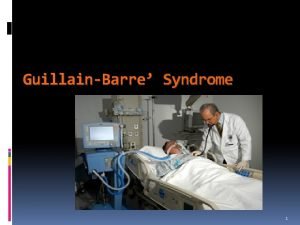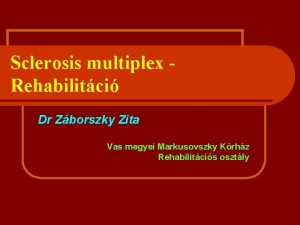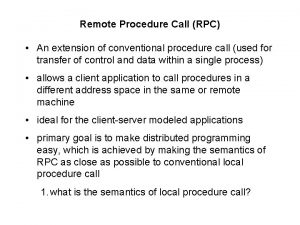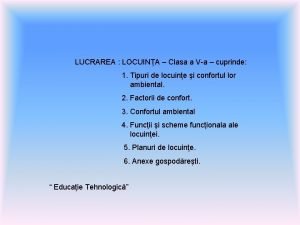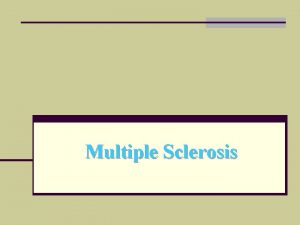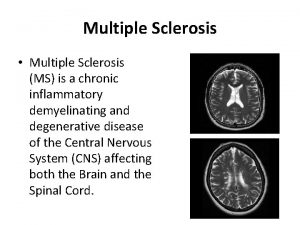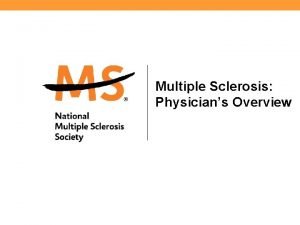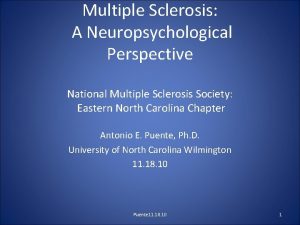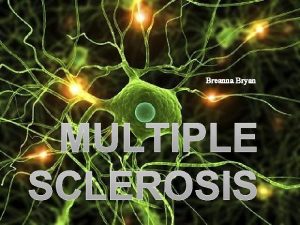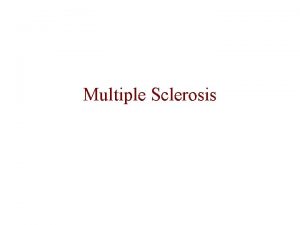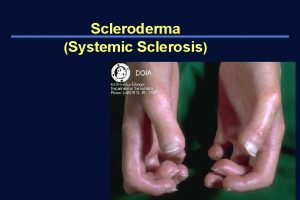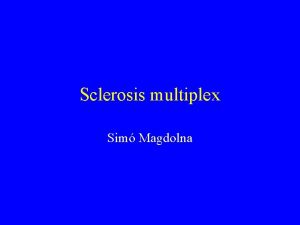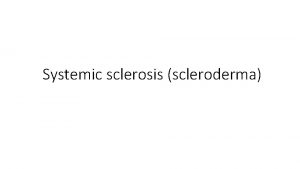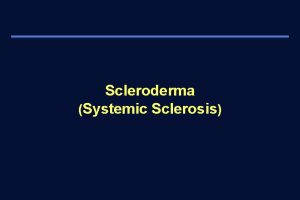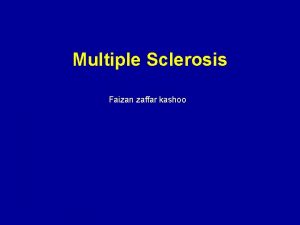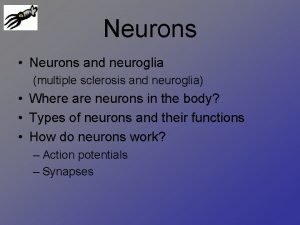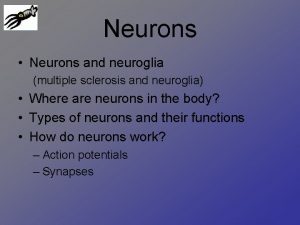Multiple Sclerosis A Review of Conventional and NotSoConventional






























- Slides: 30

Multiple Sclerosis: A Review of Conventional and Not-So-Conventional MR Imaging Techniques John P. Nazarian, MD; Mojgan Hojjati, MD; Leo J. Wolansky, MD Department of Radiology University Hospitals Case Medical Center Case Western Reserve University School of Medicine Cleveland, Ohio Control #: 1418 e. Ed. E-23

Disclosures The authors of this presentation have no financial disclosures.

Purpose 1. Provide an image-rich review of conventional MR imaging in patients with multiple sclerosis (MS). 2. Introduce the user to advanced imaging techniques being investigated for their value in diagnosing, monitoring treatment, and better understanding the pathophysiology of MS.

Multiple sclerosis: Overview § Debilitating inflammatory disease of the central nervous system • Major cause of neurological disability in adults • Usually diagnosed between age 20 and 50 • More common in women § Underlying pathophysiology incompletely understood, but mediated via autoimmune mechanisms § Variable clinical manifestations • Common initial presentations include optic neuritis, motor and sensory deficits, transverse myelitis, and brainstem syndromes • Multiple clinical phenotypes (patterns of disease progression)

Multiple sclerosis: Diagnosis § Mc. Donald criteria – most commonly used method of diagnosis • Based on clinical and paraclinical (radiologic and laboratory) findings § Current role of imaging (MRI) • Visualization of T 2 -hyperintense white matter lesions (demyelinating plaques) • Demonstrate dissemination of lesions in space and time for diagnosis • Treatment monitoring in patients with established MS

Conventional MRI Findings

Multiple sclerosis These axial T 2 images and single sagittal FLAIR image show numerous round and ovoid lesions in the centrum semiovale and periventricular white matter. Characteristic MS lesions (“plaques”) are oval or ovoid, larger than 5 mm in diameter, and are often oriented with their long axis perpendicular to the ventricular surface.

Characteristic location of MS lesions Lesions tend to occur where the CSF contacts the white matter – along the lateral ventricles, the corpus callosum, brainstem, and optic nerve pathways. The axial and sagittal FLAIR images above (left and center) show numerous periventricular and subependymal lesions. The axial T 2 image (right) demonstrates lesions in the pons and cerebellar peduncles, adjacent to the cisternal surfaces.

“Dawson’s fingers” This sagittal FLAIR image shows the characteristic “fingers” of high signal extending perpendicular to the ependymal surface. Images courtesy of Rohit Bakshi, MD

Another example of periventricular demyelination, in this case much more extensive and confluent. Note the extension of the hyperintense lesions into the subcortical white matter. Images courtesy of Mario Cirillo, MD

Early development of subependymal lesions in the corpus callosum – the ependymal “dot-dash sign. ” This has been described as a sensitive early imaging finding for MS. Image courtesy of Mario Cirillo, MD

T 1 hypointense lesions Some chronic MS plaques, also known as “black holes”, appear hypointense on pre- and post-contrast T 1 -weighted images. These “black holes” have been found to represent irreversible axonal loss. Some studies have shown a correlation between volume of these lesions and clinical disability (though this is not clearly established).

Contrast enhancement Gadolinium enhancement can serve as a surrogate for disease activity. Lesions which enhance on post-gadolinium T 1 -weighted images correlate to acute to subacute inflammation and demyelination; in one study, 100% (40/40) of histologically active lesions showed some form of contrast enhancement.

In this case, several hyperintense lesions are visible on T 2 and FLAIR sequences (top two images) in the left and right hemispheric white matter, but only one enhances on the post-gadolinium T 1 images (bottom right). Approximately 90% of enhancing lesions will enhance for less than 8 weeks, and most of these will persist as T 2 hyperintese foci. Only about half, however, will become T 1 “black holes”. Images courtesy of Mario Cirillo, MD

The “open ring sign”, in which the lesion shows incomplete ringenhancement, has been described as typical for MS and allows differentiation from neoplasms. It is thought to represent an advancing front of demyelination.

Tumefactive MS Some MS lesions can appear quite atypical. The postcontrast T 1 images in the top row show a large lesion with mass effect and incomplete peripheral enhancement. These “tumefactive” lesions can be difficult to differentiate from tumor or abscess. Note the abnormal diffusion restriction (DWI and ADC, bottom left and right) present at the edge of the lesion – this has been described as another sign of acute demyelination and inflammation. Images courtesy of Mario Cirillo, MD

These post-gadolinium T 1 -weighted images were obtained in a 25 -year-old man who presented with seizures. Several peripherally enhancing mass-like lesions are seen in the left temporal lobe (a), medial right frontal lobe (b) and posterior medial left frontal lobe (c). The incomplete rim enhancement has been classically described in association with tumefactive demyelinating lesions.

MS in the spinal cord MS involves the spinal cord in at least 70 -80% of cases (even more on autopsy studies). Most spinal lesions occur in the cervical spine. Typical cord lesions are peripherally located and do not involve the entire cross-sectional area of the cord. They are generally less than two vertebral bodies in craniocaudal length. These axial (left, top and bottom) and sagittal (right) T 2 -weighted images acquired in a 34 -year old woman with multiple sclerosis show multifocal signal abnormalities within the cervical cord, particularly in the posterior columns.

Optic nerve involvement MS is the most common cause of optic neuritis, and optic neuritis is one of the most common clinical syndromes in MS patients at initial presentation. Fat suppression is very helpful in evaluation of the intraorbital optic nerve. This coronal STIR image shows hyperintensity in the left optic nerve and surrounding nerve sheath consistent with inflammatory changes.

Advanced Imaging Techniques

Imaging at higher field strengths MRI performed at higher magnetic field strength increases the signalto-noise ratio of the images and increases the sensitivity of MR for detecting T 2 -hyperintense white matter lesions. 1. 5 T 3 T

Another example of improved lesion visualization at higher magnetic field strength – notice how much more conspicuous this lesion is on the 3 T images! 1. 5 T 3 T

Triple-dose gadolinium Imaging after administration of triple-dose gadolinium (0. 3 mmol/kg) has been shown to improve lesion conspicuity and increase the lesion detection rate relative to single-dose gadolinium. 0. 1 mmol/kg 0. 3 mmol/kg

MR perfusion imaging T 1 -weighted volumetric images (a and c) with perfusion sequences (dynamic susceptibility contrast-enhanced; DSC, b and d). Perfusion images show low relative cerebral blood volume (r. CBV) in the lesions, making tumefactive demyelination more likely than malignancy in this case. High-grade malignancy would typically display r. CBV similar to cortex (red areas on the perfusion images).

MR spectroscopy Multivoxel MR spectroscopy performed at the level of the medial right frontal lesion in the same patient, demonstrating reversal of Hunter’s angle with elevated choline peaks with respect to NAA. The left image demonstrates a potential pitfall – the choline/NAA ratio is elevated (red spot), which could be mistaken for focal malignancy; however, correlation with the absolute choline values (not shown) revealed no elevation of choline in this region. The elevated choline/NAA ratio was due to a decrease in NAA, an entirely nonspecific finding. This lesion resolved spontaneously and is consistent with tumefactive demyelination.

Diffusion tensor imaging (DTI) allows measurement of the random diffusional motion of water molecules, permitting calculation of fractional anisotropy (directional dependence of water diffusion). Reduced anisotropy correlates with demyelination and axonal loss in MS. The color-overlay in the image on the right shows a reduction in anisotropy (yellow) corresponding to a visible peripheral lesion in the left posterolateral aspect of the cord (left image). The gray matter in the center of the cord also has diffused anisotropy relative to the surrounding white matter. Images courtesy of Mario Cirillo, MD

Double-inversion-recovery (DIR) Though usually considered a “white matter disease”, MS involves the gray matter as well. Cortical lesions are often not seen due to their small size, poor contrast against the adjacent tissue, and partial volume averaging effects from adjacent CSF. DIR sequences use two inversion times to suppress both white matter and CSF signal. These images show markedly increased conspicuity of cortical lesions on DIR compared to intermediateweighted, T 2, and FLAIR images. Published in: "MR Imaging of Multiple Sclerosis" Filippi and Rocca Radiology Vol. 259, No. 3: 659 -681 ©RSNA, 2011

Magnetization transfer MR imaging § T 2/FLAIR lesions visible on conventional MR are not the only areas of white matter affected in MS – abnormalities are present in the normal-appearing white matter (NAWM) as well. § Magnetization transfer ratio (MTR) • • • Calculated by performing spin-echo or gradient echo MR sequences with and without an off-resonance saturation pulse Reduction in MTR indicates reduced ability of protons bound to brain tissue matrix to exchange magnetization with surrounding free water – allows estimation of disruption of surrounding tissue Several studies have shown that in some lesions, dramatic changes in NAWM can be identified days to weeks before the development of new enhancing lesions!

References 1. Filippi M, Rocca MA, De Stefano N, et al. Magnetic resonance techniques in multiple sclerosis: the present and the future. Arch Neurol 2011; 68(12): 1514 -20. 2. Filippi M, Rocca MA. MR imaging of multiple sclerosis. Radiology 2011; 259(3): 659 -81. 1. 3. Lisanti CJ, Asbach P, Bradley WG, Jr. The ependymal "Dot-Dash" sign: an MR imaging finding of early multiple sclerosis. AJNR. American journal of neuroradiology. 2005; 26(8): 2033 -2036. 4. Lovblad KO, Anzalone N, Dorfler A, et al. MR imaging in multiple sclerosis: review and recommendations for current practice. AJNR Am J Neuroradiol 2010; 31: 983– 9. 5. Nesbit GM, Forbes GS, Scheithauer BW, Okazaki H, Rodriguez M. Multiple sclerosis: histopathologic and MR and/or CT correlation in 37 cases at biopsy and three cases at autopsy. Radiology. 1991; 180(2): 467 -474. 6. Miller TR, Mohan S, Choudhri AF, et al. Advances in multiple sclerosis and its variants: conventional and newer imaging techniques. Radiol Clin North Am 2014; 52(2): 321 -36. 7. Sahraian MA, Radue EW, Haller S, et al. Black holes in multiple sclerosis: definition, evolution, and clinical correlations, Acta Neurol Scand. 2010; 122: 1 -8. Wolansky LJ, Bardini JA, Cook SD, Zimmer AE, Sheffet A, Lee HJ. Triple-dose versus single-dose gadoteridol in multiple sclerosis patients. Journal of neuroimaging : official journal of the American Society of Neuroimaging. 1994; 4(3): 141 -145.

Special thanks Mario Cirillo, MD Assistant Professor of Neuroradiology Second University of Naples, Italy
 Ms title
Ms title Concept map multiple sclerosis
Concept map multiple sclerosis Virus multiple sclerosis
Virus multiple sclerosis Concept map of assessment
Concept map of assessment Záborszky zita
Záborszky zita Tuximab
Tuximab Aspiration biopsy
Aspiration biopsy Multiple baseline vs multiple probe design
Multiple baseline vs multiple probe design Example of mimd
Example of mimd Chapter review motion part a vocabulary review answer key
Chapter review motion part a vocabulary review answer key Uncontrollable spending ap gov
Uncontrollable spending ap gov Narrative review vs systematic review
Narrative review vs systematic review Systematic review definition
Systematic review definition Narrative review vs systematic review
Narrative review vs systematic review What is the language in
What is the language in Conventional encryption and message confidentiality
Conventional encryption and message confidentiality Rules of ijarah
Rules of ijarah Conventional symbols in map
Conventional symbols in map Iterative planning process
Iterative planning process Conventional computing and intelligent computing
Conventional computing and intelligent computing Example of decorative design
Example of decorative design List some remote procedure call (rpc) issues.
List some remote procedure call (rpc) issues. Conventional layered flexible pavement
Conventional layered flexible pavement Conventional representation of external screw thread
Conventional representation of external screw thread What are the 7 steps of moral reasoning model
What are the 7 steps of moral reasoning model Kohlberg's stages
Kohlberg's stages Kohlberg conventional stage
Kohlberg conventional stage Conventional marketing system
Conventional marketing system Planul locuintei semne conventionale
Planul locuintei semne conventionale Post conventional morality
Post conventional morality Moral development
Moral development



